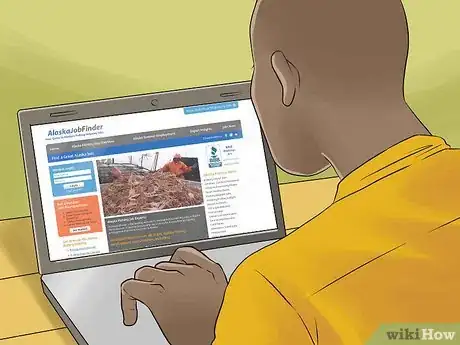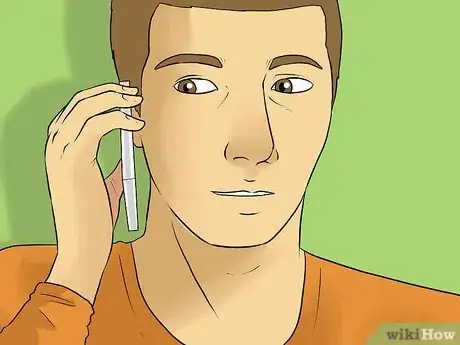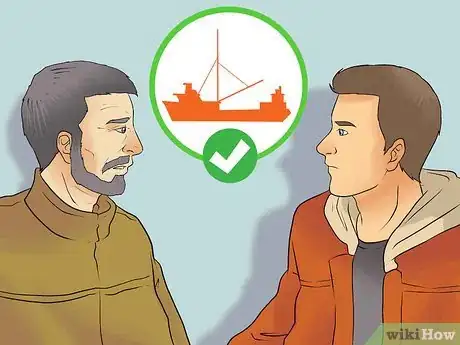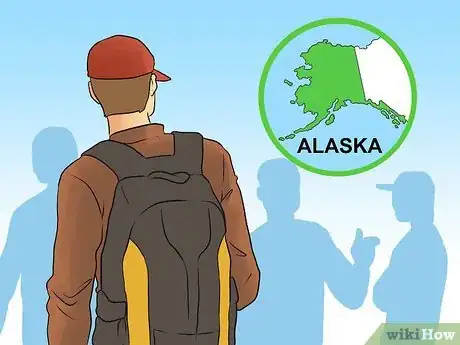This article was co-authored by wikiHow Staff. Our trained team of editors and researchers validate articles for accuracy and comprehensiveness. wikiHow's Content Management Team carefully monitors the work from our editorial staff to ensure that each article is backed by trusted research and meets our high quality standards.
wikiHow marks an article as reader-approved once it receives enough positive feedback. In this case, 87% of readers who voted found the article helpful, earning it our reader-approved status.
This article has been viewed 146,930 times.
Learn more...
Thanks to TV shows like Deadliest Catch and Alaska Fish Wars, interest in the Alaskan fishing industry has never been higher. But where does a prospective Alaskan greenhorn begin if they want to either work for a summer on a boat or start a full-fledged career? It turns out that they can start right here. Prepare yourself for challenges and start your job search so that you can get your feet wet in the Alaskan fishing industry.
Steps
Getting Ready
-
1Establish your objectives and set your schedule accordingly. Are you trying to start a full-fledged career, or are you more interested in getting a short-term entry level job and seeing how things go? While there are thousands of crew positions available in Alaska during the summer and demand for hard-working people is high, you don't have a chance of getting hired if you can't set aside significant time in your schedule.
- Typically you will need a minimum of two months clear to land an entry level job in Alaska. Most entry-level jobs for those with little or no experience are on salmon boats called trollers, gill netters, and purse seiners.
- The salmon season begins in May and extends into the fall.[1] The longer your availability is within this window, the more likely it is that you will find a job.
-
2Build muscle and endurance. All jobs in the Alaskan fishing industry, and especially entry level jobs, are strenuous and grueling. You will be placing yourself in a highly stressful and demanding environment. A fishing boat is not a place where you can work yourself into shape. You'll need to be fit in advance.
- When getting in shape for a fishing job, it is best to focus on building up functional strength. Being able to run ten miles or bench press 250 pounds won't do you as much good working 18 hour days on a fishing boat as core stability and overall functionality.
Advertisement -
3Develop mental and emotional strength. Understand that your body won't be the only thing that will be tired at the end of an 18-hour day. Your mind will be worn out and your emotions frayed. As is frequently illustrated on TV shows that deal with the Alaskan fishing industry, the captain and rest of the crew can be particularly hard on green hands. Learn to deal with stress accordingly. [2]
- Different people prepare themselves in different ways mentally and emotionally. Find a way that works for you.
- Focus on developing both a learning attitude and a thick skin when it comes to criticism.
-
4Assess your financial situation. As the old saying goes, sometimes it takes money to make money. As you'll discover on your job search, it can be very difficult to land a guaranteed job in advance prior to going to Alaska. Many job seekers have to move to a fishing hub first, and look for a job in person. You'll need to have the financial wherewithal to secure yourself housing and cover basic expenses if you opt for this route.
- Even if you don't move to Alaska without a job, planning to get a job in Alaska could compromise your ability to take a local job, possibly leaving you stuck at home without a summer job at all. Don't put all your eggs into one basket unless you can afford to have them broken.
Searching for Your Job
-
1Find potential employers. This process is probably going to be different than most job searches you have done in the past. As many boats are independent businesses, much of the hiring in the Alaskan commercial fishing industry is done by boat captains rather than an HR and recruiting department. There are very few resources for greenhorns looking for deckhand jobs - much of the hiring is done in-person and by word of mouth.
- There are some jobs you might be able to see on Alaska Job Finder that have been made available online.
- Alaskan Leader Fisheries also has occasional job listings and an application process for potential job seekers.
- Another website that has good resources and guidance for job seekers is Alaska Fishing Jobs Network.
-
2Contact the employers that you have found. This is easier said than done. Many potential employers might not even have email, relying instead on older technology like telephones and fax machines.
- If you lack a fax machine, you can send a fax online.
- Be aware of time zone differences when calling potential employers. Most of Alaska is in UTC -0:900, which is one hour behind Pacific Time and 4 hours behind Eastern Time. The Western Aleutian islands portion of Alaska is an hour further behind.[3]
-
3Ask employers you contact for additional leads and references. Many employers that you contact will either be fully staffed or not interested in hiring a green hand. However, much of the hiring in the Alaskan fishing industry is done by word of mouth and referral, and many positions won't be listed anywhere. A captain with a fully crewed boat may know of another captain in desperate need of a deckhand. If you establish good rapport with someone that doesn't have a spot for you, ask if they know of and can refer you to someone that may need your help.
-
4Consider going to Alaska and looking for a job in person. Dutch Harbor, Kodiak, and Naknek are fantastic places for a greenhorn to get started, though there are plenty of others as well. As many positions are not listed online many people are better off going an Alaskan fishing industry hub and looking for a job in person. This may be the only way to have a chance to meet a boat captain and ask them for a job. If you are unsuccessful getting a job as a deckhand, it is considerably easier to get a job in a seafood processing plant. Processing plants usually pay decent wages and are the first step in the door for many people in the fishing industry.[4]
Community Q&A
-
QuestionHow do I get a fishing job in Alaska from India?
 Community AnswerYou will need to first get a green card or work visa before you are able to start your fishing job.
Community AnswerYou will need to first get a green card or work visa before you are able to start your fishing job. -
QuestionCan I get hired if I am from Africa?
 Community AnswerYes, you can as long as you have the correct visa.
Community AnswerYes, you can as long as you have the correct visa. -
QuestionIf I'm from South Africa, how can I get a fishing job in Alaska?
 Community AnswerLook online for job openings and apply. Where you're from shouldn't matter.
Community AnswerLook online for job openings and apply. Where you're from shouldn't matter.
Warnings
- Seafood processing jobs and cannery jobs should not be confused with actual fishing jobs. While many eventual fishermen get their start in the processing industry, processing and cannery jobs are essentially factory work. You will have to work hard and deal with the mundane. If you prove yourself to be hard working and reliable your odds of being noticed by or being referred to a boat captain are significantly increased.⧼thumbs_response⧽
References
- ↑ https://www.adfg.alaska.gov/static/fishing/PDFs/commercial/commercial_season_2.pdf
- ↑ http://www.webmd.com/balance/stress-management/tc/managing-job-stress-topic-overview
- ↑ http://www.timeanddate.com/worldclock/usa/anchorage
- ↑ http://www.alaskafishingjobsnetwork.com/getting-a-job/alaska-job-search-strategy/
- ↑ http://www.FishingJobs.com
About This Article
To get a fishing job in Alaska, you'll need to be willing to commit to at least two months for an entry-level position. Also, most entry-level jobs are on salmon boats, so try to be available between May and the beginning of fall, which is when salmon season is. To find available positions, try looking online through websites like Alaska Job Finder and Alaska Fishing Jobs Network. Since a lot of the hiring in the Alaskan fishing industry is done in-person and by word of mouth, you may want to go to Alaska and visit a fishing hub to find available positions. To learn how to prepare mentally and physically for a fishing job in Alaska, keep reading!











-Step-9.webp)























-Step-9.webp)


































